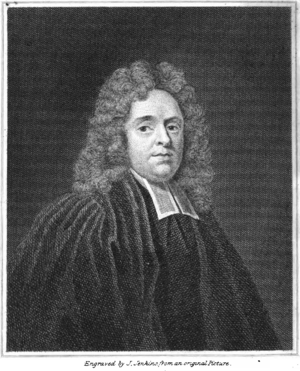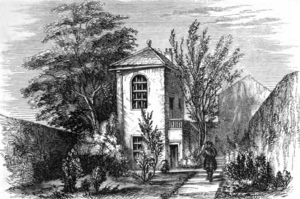Matthew Henry facts for kids
Quick facts for kids
Matthew Henry
|
|
|---|---|
 |
|
| Born | 18 October 1662 |
| Died | 22 June 1714 (aged 51) |
| Education | Gray's Inn |
|
Notable work
|
Exposition of the Old and New Testaments |
| Spouse(s) | Kathrine Hardware (1687–1689), Mary Warburton (1690-) |
| Children | 9 |
| Parents |
|
Matthew Henry (born October 18, 1662 – died June 22, 1714) was a British Nonconformist minister and writer. He was born in Wales but lived most of his life in England. He is most famous for his six-volume Bible commentary, Exposition of the Old and New Testaments.
Contents
Life of Matthew Henry
Matthew Henry was the second son of Philip and Kathrine Henry. He was born early at his mother's family home, Broad Oak. This farm was located near the borders of Flintshire and Shropshire. His father, Philip Henry, was a Church of England minister. However, he had recently been forced to leave his church. This happened because of a law called the Act of Uniformity 1662.
As a young child, Matthew often had fevers. Unlike many ministers who lost their jobs, Philip Henry had some private money. This allowed him to give his son a good education at home. Matthew's sister, Sarah Savage, was known for her diary.
Matthew Henry's Early Life and Education
By the age of nine, Matthew Henry could write in Latin. He could also read parts of the Greek New Testament. His father taught him much of his early education at home. Matthew practiced writing by copying his father's sermons. Even as a child, he showed a natural talent for public speaking.
In 1680, when he was eighteen, his father sent him to a school in Islington, London. There, he was taught by a Nonconformist minister named Thomas Doolittle. Later, Henry moved to Gray's Inn in London to study law. While studying law, he also learned French and read many books. However, he soon decided to study theology (the study of religious faith) instead of law.
His friend, George Illidge, invited Henry to give his first sermon. This was to a group of people in Nantwich. People liked his sermon, so he returned to speak two more times that summer.
Matthew Henry's Ministry in Chester
In 1686, a local Nonconformist minister asked Matthew Henry to move to Chester, Cheshire. He wanted Henry to start a new church group there. Henry was not sure at first. He did not want to take members from churches that already existed. But the minister insisted, and Henry accepted.
Henry became a minister on May 9, 1687. He presented a paper written in Latin as part of his ordination. He then became the minister of a new Presbyterian church in Chester. The church grew under his leadership. In 1699, he oversaw the building of a new church. While in Chester, Henry also started the Presbyterian Chapel in Trinity Street.
After settling in Chester, he began to travel to nearby cities to speak. He became a member of the local group of ministers in Chester. Henry once said about living in Chester, "I cannot think of leaving Chester, until Chester leaves me."
After moving to Chester, he married Kathrine Hardware on July 19, 1687. Her mother had not wanted them to marry at first. Kathrine Hardware's parents then moved to Chester, and Henry and his wife lived with them. Sadly, Kathrine died of smallpox on February 14, 1689, at age 25. This happened shortly after their first child was born. He named the baby Kathrine after her mother, but the child died 15 months later. He continued to live with the Hardwares and kept up his work as a minister.
He later met Mary Warburton, a relative of Mrs. Hardware. On July 8, 1690, he married Mary Warburton in Chester. They had several children, but some died when they were very young.
By age 26 in 1688, his many speaking events started to affect his health. He often had fevers. His father wrote to him, telling him to be careful when speaking. Henry's passionate speaking style was very popular. Sometimes, he could make his audience cry. He became a popular speaker and was always invited to speak and give lessons. He traveled almost every week to different cities to speak.
He spent a lot of time studying and writing his sermons and lectures beforehand. Henry liked to use an expository speaking style. This means he would explain a Bible passage in detail. For each talk, he would use different Bible texts to explain his topic. His way of teaching was: "Choose for your pulpit subjects the plainest, and most needful truths; and endeavor to make them plainer." When he wrote, he stuck closely to the exact meaning of Bible passages. These writings later became the basis for his famous commentary.
Between 1687 and 1712, Matthew Henry continued to live in Chester. He and his wife Mary had more children who survived to adulthood.
Matthew Henry's Journey to London
In 1698, Henry traveled to London to speak for the first time since moving to Chester. On his trip, he stopped to speak in towns like Nantwich and Lichfield. Later, he was often invited to speak in London, where he eventually moved. He traveled to London again in 1704, and this time Mary went with him.
Up until this point, his health had been quite good, even with all his hard work. In August 1704, he fainted while speaking. But he quickly started speaking again. The next two days, he traveled to Nantwich and then to Haslington. When he returned to Chester, he was sick with a fever for three weeks.
Matthew Henry's Ministry in Hackney
In 1712, he moved to Mare Street, Hackney. He accepted an invitation to lead the church group there. He started his work on May 18, 1712. The church had less than one hundred members. He also traveled to Wapping and other nearby areas to give evening lectures. Then he would return to his duties at the Hackney church. Henry also started giving catechetical lectures in London. These were lessons about Christian beliefs.
His book, Exposition of the Old and New Testaments, was almost ready to be published. Moving to Hackney, closer to the publisher, was one reason for the move. In 1713, his health started to get worse after he visited Chester again.
Matthew Henry's Death
In 1713, he began to suffer from frequent attacks of a kidney problem called nephritis. He still kept up his many speaking events and worked on his commentary. On June 21, 1714, Henry was on a speaking tour near Chester. He was returning to Hackney. On the way, he fell off his horse. He said he was not hurt and insisted on going to Nantwich, where he was supposed to speak. His friends traveling with him noticed he lacked energy. That evening, he could no longer travel. He stopped at the Queen's Aid House in Nantwich. On June 22, 1714, he died suddenly from a stroke, which was called apoplexy back then.
Matthew Henry's Literary Work
Henry's famous six-volume book is called Exposition of the Old and New Testaments. It was published between 1708 and 1710. It is also known as Complete Commentary. This work provides a detailed study of the Bible, paragraph by paragraph. It covers the entire Old Testament, and the Gospels and Acts in the New Testament.
After Henry's death, thirteen other ministers finished the sixth volume. This volume covered the books of Romans through Revelation. They used notes taken by people who had listened to Henry's sermons. The entire Commentary was later updated by George Burder and John Hughes in 1811.
Henry's commentaries focus on the meaning of the Bible for everyday life and worship. He wanted to explain the Bible in a way that helped people understand and use its teachings. Henry suggested that people who wanted a more technical study of the Bible should read Matthew Poole's Synopsis Criticorum.
Famous Protestant preachers praised and used Henry's work. These included George Whitefield and Charles Spurgeon. Whitefield read the commentary four times. Spurgeon said, "Every minister ought to read it entirely and carefully through once at least." John Wesley published a shorter version of the Commentary. He wrote that Henry was a person with "strong understanding, of various learning, of solid piety, and much experience in the ways of God." Wesley also said Henry's explanations were "clear and intelligible" and "practical throughout."
Several shorter versions of the Commentary were published in the 1900s. More recently, Martin H. Manser updated the language in The New Matthew Henry Commentary.
Famous Quotation
Perhaps Matthew Henry's most well-known quote is about the relationship between men and women. It comes from the story of Eve's creation in the Book of Genesis:
The woman was made of a rib out of the side of Adam; not made out of his head to rule over him, nor out of his feet to be trampled upon by him, but out of his side to be equal with him, under his arm to be protected, and near his heart to be beloved.
This quote was inspired by similar ideas from Peter Lombard in his book Sentences.
Memorial
In 1860, a memorial was built in Chester to remember Henry. It is a tall, four-sided pillar called an obelisk. It was designed by Thomas Harrison. It also has a bronze medal made by Matthew Noble. The obelisk was first in the churchyard of St Bridget's Church. In the 1960s, it was moved to a roundabout across from the entrance to Chester Castle.
See also



